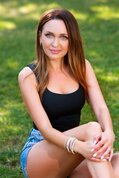|
|
|
|
|
|
Odessa’s sights & attractions, one of the most picturesque Ukrainian cities.
To begin your acquaintance with Odessa better with the historic center, the most of the attractions are located there and many of which are known outside of Odessa. We have prepared for you a guide around the city, which we hope will help you to arrange a self-guided tour and to plan your vacation, to do everything and miss nothing. Do not forget that Odessa is a big city with a population of 1 million people. If you are planning a walking tour, we advise you to wear comfortable shoes, because you'll have a lot of walking, and of course do not forget your camera.
Deribasovskaya Street.
Among the biggest attractions of Odessa, the legendary Deribasovskaya Street is of particular importance. It is not just a city street it is the heart of Odessa known to the whole world. By itself, the street is not very large, but the smoothness of life, peace of mind that comes from everywhere, rhythm, carefree and incredibly genuine sense of comfort is radiated from architectural shapes, and from cafes. Especially striking is the absence of transportation. An interesting name comes from the name of a nobleman of Spanish origin - Don Jose de Ribas, who is considered the founder of the city and the harbor of Odessa.

Potemkin Stairs.
Potemkin Stairs was originally planned as the main entrance to the city from the sea, designed by architects F.K. Boffo, A.I. Melnikov and K.I. Pottier in 1835, it was built in 1837-1841. The stairs was called the Giant, and Primorskiy, Vorontsovskiy, Nikolaevskiy, but from the official sources we know only the name of Rishelyevskaya - since its foundation it was a monument to the Count (Duke) de Richelieu the founder of the city. In 1955 the staircase was renamed in memory of the uprising on the battleship of "Potemkin".
In the middle of the XIX century stairs descends to the sea and the shore in this place was called as"Kupalnyi". Currently, the stairs still start from the Primorskiy Boulevard near the monument to the Duke de Richelieu, but now instead of the lower span of the coast it goes to the seaport.
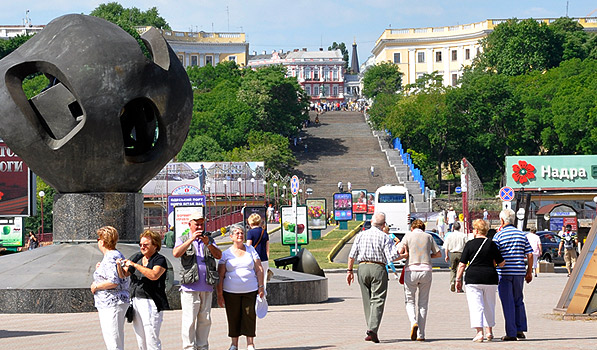
Odessa’s Opera House.
Its first building was opened in 1810 and burned down in 1873. The modern building was built in 1887 by the architects Fellner and Helmer in the style of Viennese baroque. The architecture of the auditorium is in the style of the late French rococo. The unique acoustics of the horseshoe shape hall allows conveying even a whisper from the stage to any part of the room.
The full restoration of the theater building was completed in 2007.
In the design of the facade and interior of the theater you can see the elements of the Italian Renaissance and the Viennese baroque, classical baroque and rococo, but all the stylistic components are organically linked and create a coherent composition. The main entrance to the theater is decorated with moulded embodiments of comedy and tragedy. From the left side there is a scene from the tragedy of Euripides 'Hippolytus, and from the right side there is an episode from the comedy of Aristophanes' Birds." On the balustrade of the building are 16 figures of putti (babies, cupids), each of which is unique and does not repeat the rest.
In round niches of the upper floor of the pediment of the building there are the busts of the Great Russian authors - Alexander Pushkin, Alexander Griboyedov, Nikolay Gogol and Mikhail Glinka. They represent a poetry, a drama, a comedy and music.
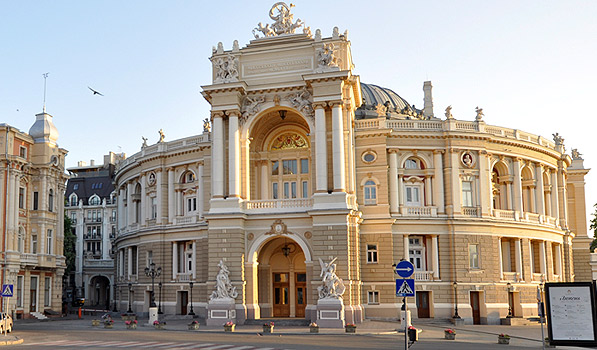
Palais Royal.
Palais Royal Garden is a secret attraction of the city, because it is hidden from the eyes by the surrounding buildings. To visit it – it means to touch the other, romantic, thoughtful, quiet side of Odessa. But every corner of the city is beautiful, and you can admire the beautiful old sculptures here too.
The idea of its creation belongs to Elizabeth Ksaver’evna Vorontsova. This garden located in the center just behind the Opera House, and today amazes all the visitors by it’s the sudden silence and distant location from the city.
It is decorated with a cozy and quiet fountain, built in 1847, with a bronze sad girl on the top of a cliff made of stone, and a couple of Cupid and Psyche who hug each other, nestled here from 1900 on the green lawn, and above them and all this oasis of harmony and beauty there is a continuous carpet from leaves and branches.
Nowadays and how it was in old times, there are four entrances to the garden: two from the Opera House from Lanzheronovskaya Street and Tchaikovskiy lane and from Ekaterineskaya Street are two special entrances through which you get in the garden of Palais Royal and it is always unexpected, going next to high and narrow entrances of the house. Any of these entrances are amazing and mysterious. From a noisy the city that is in perpetual motion, the person who comes here is teleported somewhere else, even to another century - almost everything in this historic garden remained the same, which gives people a wonderful opportunity to see one of the corners of Odessa as it was over a hundred years ago.
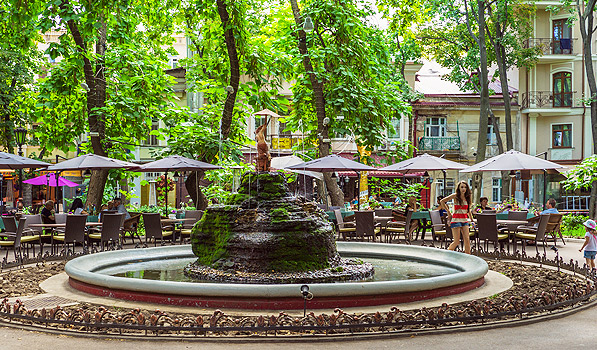
Passage.
Hotel "Passage” is a hotel and covered shopping areas, a historical and architectural monument of the late XIX - early XX century in the city of Odessa, located in Preobrazhenskaya street, 34. In 1822, the primary structures which belonged to two Russian officers from the end of the XVIII century, were passed into the hands of the new homeowner – M.A Kramarev.
The homeowner Michael Antonovich Kramarev was a very well-known and respected man in Odessa in 1820-1830. He was a merchant of the first guild, one of the directors of the Odessa’s office of the State Commercial Bank from merchants, a board member of the Prikaz of public charity (the province institution), a trustee of the city hospital, etc., Kramarev has an enormous prestige and influence, for example, he was the real estate appraiser, served as a treasurer of the Duma, etc. Created by him a trading house is mentioned in the register of large commercial firms of the era of Richelieu.
Passage was one of the best in Odessa that time according to the financial appraisal: built in the spirit of Russian Classicism, with pilasters on the facade, the longest, two-story on a high base building, As a landmark the building of Kramarev was showed to Tsar Nikolay I during the visit of the emperor to South Palmyra. Passage was the most grandiose structure in Odessa during those times. The accommodation here was considered very prestigious.
The name of the building - "Passage" is in one of the version of the translation from French means "the corridor on both sides of which there are shops." After the finishing of the building of “Passage “it was a new type of shopping center. The first floor was originally equipped as trading areas.
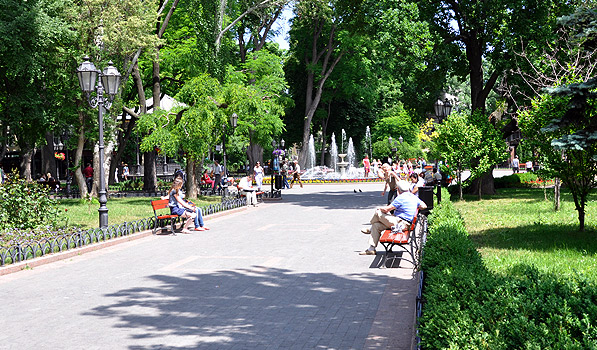
The City Garden.
The City Garden is located in the center of the city and goes to the three streets - Deribasovskaya, Preobrazhenskaya and Havannaya. When at the end of the XVIII century the residents of Odessa began to receive documents on the accommodation land (with the necessity to build their accommodation there), among the first owners of such documents was the Major Felix de Ribas (1769-1845, the brother of Admiral Joseph de Ribas). Before his house there were left almost 5 acres of unused land. F. de Ribas decided to plant the trees. The first trees planted in a hot dry climate, were Acacia, which todayyou can see almost everywhere in the central streets. Major regularly got to a variety of exotic flora from Sophievskiy Park in Uman and also brought young plants and seeds from Spain and Italy.
To water the plants they brought the water from Kolodeznyi alley. There were several gardeners who care of the garden and lived in Sadovaya Street. The garden became the most popular rest area for Odessa’s nobility, which is not surprising: there were not such places with a luxurious greenery in the city. The City garden and the surrounding neighborhoods gain the status of the most prestigious districts of Odessa. From the Deribasovskaya Street the City Garden is decorated with two bronze sculptures of a lion and lioness. They were brought from France in the middle of XIX century.

Once you visit the most of the attractions of Odessa located in the heart of the city, we recommend you to walk by Frantsuzkiy Boulevard; here you will see luxurious mansions built in late XIX-early XX centuries, wineries, resorts and other institutions. This is a very unique part of Odessa, where it feels like a time stopped, and the atmosphere stimulates you for a walk in the shades of century-old trees. No wonder the movie makers love this place for the shooting of historical films.
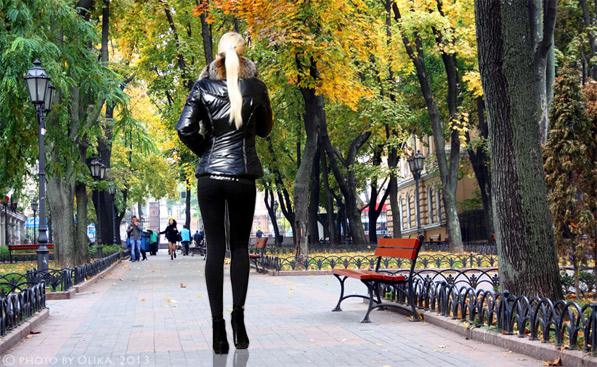
If you are lonely and can’t meet a woman of your dream in your country, you may try taking a risk and trying ‘to buy’ a bride for yourself. In the internet era you can easily get acquainted with a woman living on the other side of Earth and get married with her
